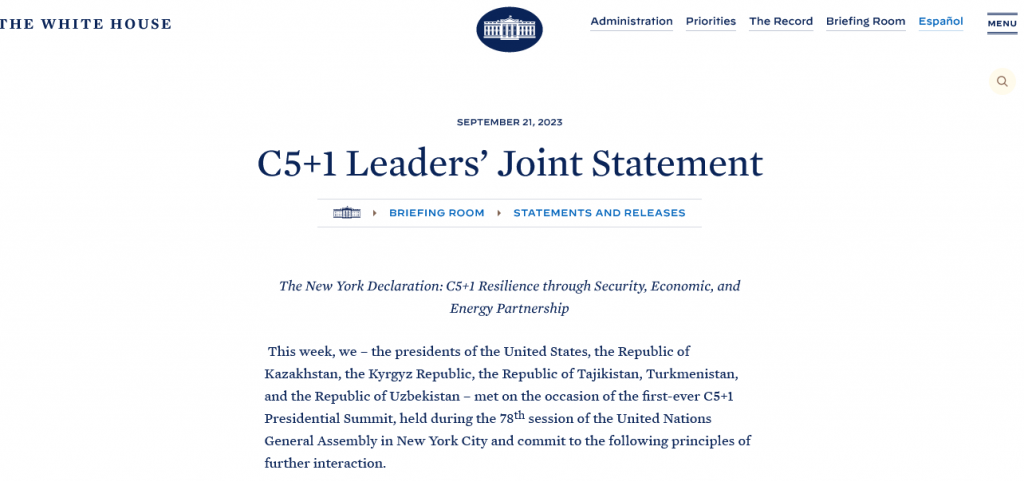by Haydar Oruç
The opening ceremonies of the 78th session of the United Nations, marked by calls for reform, finally came to a close after leaders addressed the General Assembly from September 18-22. During this time, regardless of the UN agenda, some countries and leaders had the opportunity to hold bilateral or multiple meetings. The most notable of these was the C5+1 summit that US President Biden organized with the leaders of five Central Asian countries.
The US dialogue with the C5 – Kazakhstan, Kyrgyzstan, Tajikistan, Turkmenistan, and Uzbekistan – actually dates back to 2015. However, the summit held in New York on September 19 was the first of its kind as it was held at the leaders’ level and face-to-face.

In the joint declaration released by the White House at the end of the summit, it was stated that the purpose of the summit was to enhance regional security, improve economic resilience, promote sustainable development, combat climate change and promote peace.

The topics of the agenda were “resilience through partnership, enhanced security cooperation, C5+1 economy and energy corridor, enhancing energy security, combating the effects of climate change, partnership through people and towards a new partnership environment”.
It is clear from the purpose of the summit and the topics discussed that the United States intends to engage in comprehensive cooperation with these five Central Asian countries going forward. There must surely be important reasons behind this desire for such comprehensive cooperation. Because, while the US currently has two chronic issues to deal with, namely the Russia-Ukraine war and China’s growing influence in the world, there must be a real rationale for its interest in these five Central Asian countries, which are not very influential in world politics.
It would not be a misreading to associate this interest with breaking the influence of Russia and China over the Central Asian countries. Indeed, according to Hunter Stoll, defense analyst at the RAND Corporation, who commented on the summit,
“Central Asia’s deteriorating relations with Russia and growing skepticism about Chinese influence have created a window of opportunity for the United States to strengthen its image by investing more long-term in the region.”
Naturally, the US will seize this opportunity and try to liberate the countries of the region from the influence of Russia and China, and possibly position them closer to itself.
In fact, the US interest in the region is not new. As is known, after the collapse of the Soviet Union, the US tried to have a say in the region through Turkey. Even though it was not fully understood at the time, it was based in Turkish schools opened in the countries of the region as a FETO project and tried to fill the space left vacant by the Soviet Union. However, they could not fully achieve their goals after the Russian Federation realized the situation and closed FETO schools.
Nevertheless, until recently, FETO schools continued to exist in most of these Central Asian countries and the U.S. used them to consolidate its influence in the region. It should also be noted that the U.S. was in contact and cooperation with these countries during its 20-year occupation of Afghanistan, at least for security reasons.
In other words, it is possible to say that the US’s interest in this region, which it sees as the backyard of Russia and China, is not new, but has been going on since the 1990s.
However, at the very moment when the US is pressuring Russia for its aggression against Ukraine and has announced the India-Middle East and Europe Economic Corridor (IMEC) as an alternative to China’s Road-Belt project, launching a dialogue process with Central Asian countries in the C5+1 format shows that the US will not hesitate to use any option to weaken these two rivals.
On the other hand, the “C5+1 Critical Minerals Dialogue” announced at the summit is interpreted as a step towards reducing or even completely ending the dependence of not only the US but almost the whole world on China for critical minerals. This is because the countries in the region, especially Kazakhstan, are rich in critical minerals needed for clean energy and nuclear studies, and they are emerging as new alternatives to reduce dependence on China in this regard.
The joint statement concluded liked as, “Our teams will hold regular bilateral and joint meetings, and we are committed to continuing our engagement through C5+1 ministerial meetings on issues such as trade, energy, climate, and security. We will strive to maintain a high-level dialogue to jointly address emerging challenges and ensure that our partnership continues to deliver practical results for our people.” This statement shows us that it is clear that this process will be long-term, and that the United States will remain engaged in the region until it achieves its above-mentioned goals.

The countries of the region attract the attention of not only the United States but also many other regional and global actors due to their underground and above-ground riches as well as their location on international trade routes. As such, in the past year or two, similar to the summit with the United States, various meetings have been held with Russia, China, India, the Gulf Cooperation Organization, the European Union, and even Turkey under the auspices of the Organization of Turkic States. Interestingly, similar statements have been used in almost all of these meetings.

In this case, the most important question mark for us is to what extent these Central Asian countries, all of which are members of the Organization of Turkic States except Tajikistan (Turkmenistan is an observer member), can adhere to the 2040 Vision of the Organization of Turkic States, of which Turkey is a signatory. In other words, although the dialogue between the US and the C5 is generally said to be targeting Russia and China, it should be noted that it also poses a threat to Turkey, which has future projections in this region.
The most important reason for such a view is that Turkey, which is both a NATO member and an EU candidate country, has relatively distanced itself from the Western alliance due to vital problems with the US and the EU, and as such, the US is likely to ignore Turkey’s interests in its projection towards the region and even harm these interests.
The negative attitude of the US towards Turkey’s rights and interests in Syria, Northern Iraq, the Eastern Mediterranean, the Sea of Islands, and most recently in the Black Sea due to the Russia-Ukraine war, the exclusion from the F-35 project due to the S-400 crisis, the implementation of CAATSA, and the subsequent adoption of an attitude incompatible with the alliance, such as linking the sale of F-16s to the approval of Sweden’s NATO membership, can inevitably be perceived as the US using the relationship it has developed with the Central Asian countries against Turkey and breaking Turkey’s influence in the region and ensuring its exclusion from the region.

In conclusion, the United States has managed to enter Central Asia, a region it has long been interested in, by taking advantage of the uncertainty caused by the Russian-Ukrainian war, and has thus taken an important step to break the influence of both Russia and China in the region. However, considering that the US prioritizes only its own interests in the regions it enters and may want to eliminate the influence of other interest groups, it is understood that this situation may also be seen as a threat to Turkey, which has very close relations with the region.
Ultimately, alliances are one thing and the national interests of states are another. For us, of course, our own national interests should be our main concern.
This article was originally published in Diriliş Postası on October 3, 2023, in Turkish.






